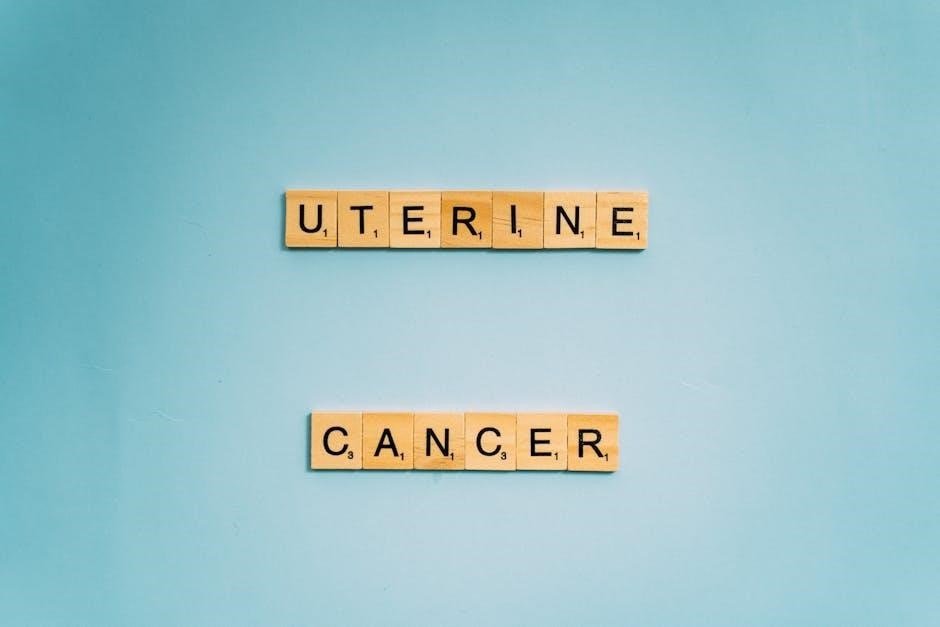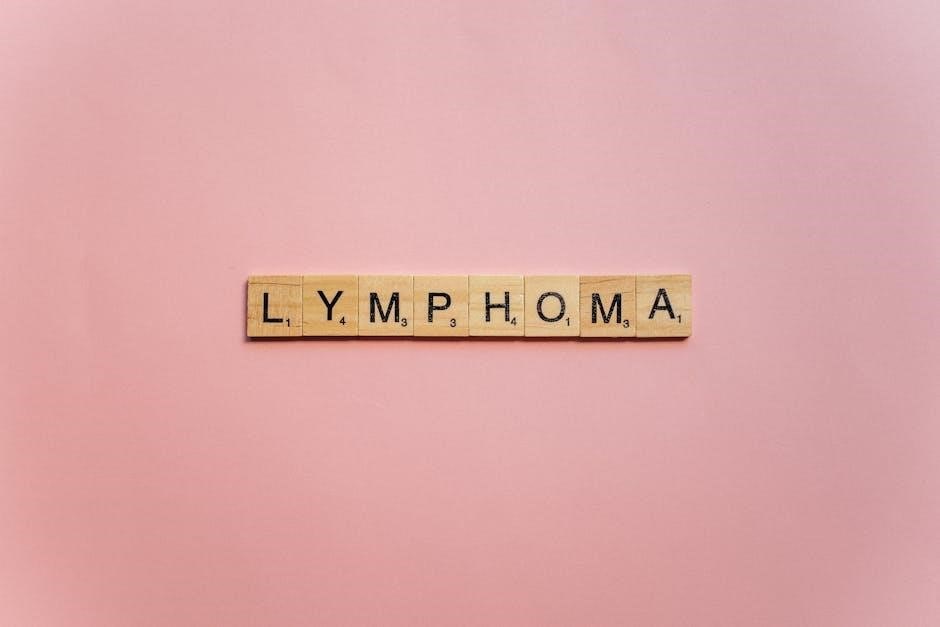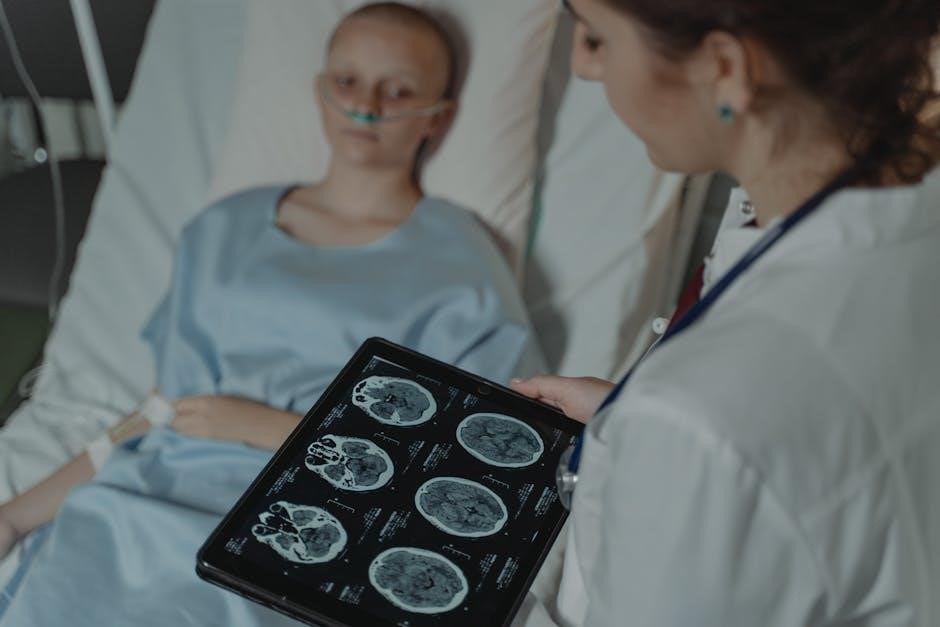Fake cancer diagnosis letters are fraudulent documents designed to deceive individuals or institutions, often for emotional manipulation or financial gain, leveraging psychological vulnerabilities and trust in medical authority.
Definition and Overview
A fake cancer diagnosis letter is a fraudulent document falsely indicating a cancer diagnosis, often forged to manipulate individuals or systems for emotional, financial, or malicious purposes.
These letters typically mimic the format of legitimate medical documents, including letterhead, signatures, and medical jargon, to appear authentic. They are frequently distributed as PDF files, exploiting the trust associated with digital medical records.
The creation and dissemination of such documents exploit vulnerabilities in verification processes and the emotional sensitivity surrounding cancer diagnoses. This deception can lead to severe psychological distress, financial exploitation, or misuse of medical resources, undermining trust in healthcare systems and professionals.
The Rise of Fake Medical Documents
The rise of fake medical documents, including cancer diagnosis letters, has become a growing concern in recent years. Advances in technology and the ease of creating convincing PDF files have enabled individuals to forge realistic-looking medical documents. These fraudulent letters often exploit the trust associated with official medical correspondence, making them difficult to identify as fake. The increasing prevalence of such documents highlights the vulnerabilities in verification processes and the potential for malicious exploitation. This trend underscores the need for heightened vigilance and improved authentication methods to combat the spread of fake medical documents and protect individuals from emotional and financial harm. The psychological impact of such deception further exacerbates the urgency of addressing this issue.
Why Fake Cancer Diagnosis Letters Are Created
Fake cancer diagnosis letters are often created for malicious purposes, including emotional manipulation, financial exploitation, or to gain sympathy. Some individuals may fabricate these documents to avoid work or gain insurance benefits, while others do so to control or deceive loved ones. In cases of Munchausen Syndrome, perpetrators may fake illnesses for attention. The ease of creating convincing PDFs has made it simpler to produce fraudulent letters that appear legitimate. These documents exploit the trust people place in medical professionals, making them powerful tools for deception. The creation of such letters underscores the darker aspects of human behavior, where vulnerabilities are exploited for personal gain, causing emotional distress and financial harm to victims. Awareness of these motives is crucial for prevention and protection.

Understanding the Components of a Fake Cancer Diagnosis Letter
Fake cancer diagnosis letters often include forged doctor signatures, false test results, and misleading prognoses, designed to appear authentic by mimicking real medical documentation and terminology.
Common Elements of Fake Letters
Fake cancer diagnosis letters often contain forged doctor signatures, false test results, and misleading prognoses. They may include fabricated medical jargon to appear authentic. These documents typically lack official medical institution letterheads or proper formatting. Fake letters frequently exploit emotional vulnerabilities, creating a sense of urgency or hopelessness. They may also include false treatment plans or prognosis timelines to manipulate the recipient. Some fake letters even mimic real medical terminology to deceive patients or institutions. However, they often lack essential details like specific diagnosis codes or treatment protocols. These elements make fake letters convincing but ultimately harmful, causing emotional distress and financial loss.
How Fake Letters Mimic Real Medical Documents
Fake cancer diagnosis letters often replicate the structure and language of genuine medical documents to deceive recipients. They may include forged letterheads, stolen logos, and realistic formatting to appear authentic. Fake letters frequently incorporate medical jargon and terminology to mimic professional communication. They may also imitate the tone and style of real diagnosis letters, including empathetic language to gain trust. Some fake letters even include fake signatures, dates, and reference numbers to enhance credibility. By closely resembling real medical documents, these fraudulent letters can convincingly manipulate individuals, causing emotional distress and financial harm. Their deceptive authenticity makes them particularly dangerous and challenging to identify without expert verification.
The Role of PDF Formatting in Fake Letters
PDF formatting plays a significant role in creating convincing fake cancer diagnosis letters. Fraudsters often use professional templates with medical letterheads, logos, and formatting to mimic real documents. PDFs are favored for their fixed layouts, which maintain the appearance of authenticity across different devices. They can include embedded fonts, images, and digital signatures to enhance legitimacy. Some fake letters even use password protection or encryption to appear secure. The use of PDFs allows scammers to distribute fake documents widely without the content being easily altered. This formatting makes it difficult for recipients to distinguish between genuine and fraudulent letters, increasing the effectiveness of the deception and its potential harm.

Psychological Impact of Receiving a Fake Cancer Diagnosis
Receiving a fake cancer diagnosis letter causes severe emotional trauma, anxiety, and stress, often leading to long-term mental health issues and strained relationships due to the deception.
Emotional Trauma on Patients and Families
Receiving a fake cancer diagnosis letter inflicts severe emotional trauma, causing patients and families to experience intense anxiety, fear, and a sense of hopelessness. The shock of such deceptive news can lead to mental health struggles, including depression and PTSD. Families often face strained relationships as they cope with the false reality, while also dealing with the financial and emotional burden of unnecessary medical preparations. The betrayal of trust in medical professionals exacerbates feelings of vulnerability. This traumatic experience can have long-lasting effects, affecting overall well-being and trust in healthcare systems. The emotional toll on victims and their loved ones is immeasurable and deeply devastating.
The Mental Health Consequences of Deception
Receiving a fake cancer diagnosis letter leads to severe psychological distress, including anxiety, depression, and post-traumatic stress disorder (PTSD). The deception shatters trust in medical professionals, causing feelings of betrayal and vulnerability. Victims often struggle with prolonged emotional turmoil, questioning their own reality and judgment. The mental health impact extends beyond the individual, affecting family dynamics and relationships. Long-term consequences may include heightened stress levels, difficulty coping with future medical issues, and a pervasive sense of insecurity. The emotional and psychological scars left by such fraud can be as damaging as any physical illness, requiring extensive therapy and support to heal.
Trust Issues in Patient-Doctor Relationships
Fake cancer diagnosis letters severely erode trust in patient-doctor relationships, a cornerstone of effective healthcare. When patients discover they have been deceived, feelings of betrayal and skepticism emerge, often leading to a breakdown in communication. This mistrust can extend beyond the immediate perpetrator, causing patients to question the credibility of all medical professionals. The emotional impact further strains the relationship, as patients may feel vulnerable and unsure of how to navigate future medical concerns. Such breaches of trust not only harm individual relationships but also undermine faith in the medical system as a whole, making it challenging for patients to seek or accept legitimate care in the future.

Legal Consequences of Forging a Cancer Diagnosis
Forging a cancer diagnosis letter leads to severe legal repercussions, including criminal charges for fraud, potential prison sentences, and significant financial penalties for perpetrators.
Legal Ramifications for Creating Fake Letters
Creating fake cancer diagnosis letters carries severe legal consequences, including criminal charges for fraud, forgery, and uttering a forged instrument. Perpetrators face substantial fines, potential imprisonment, and civil lawsuits for damages. These actions breach trust in the medical system, violating ethical standards and professional codes of conduct. Legal penalties vary by jurisdiction but often include felony charges, especially if financial gain or emotional manipulation is involved. Additionally, individuals found guilty may face long-term repercussions, such as difficulty finding employment or loss of professional licenses. The legal system treats such offenses seriously, reflecting the gravity of exploiting vulnerable individuals and undermining healthcare integrity.
Medical Malpractice and Ethical Violations
Fake cancer diagnosis letters constitute a grave breach of medical ethics, undermining patient trust and the integrity of healthcare systems. Doctors involved in such fraud face severe professional consequences, including license revocation and expulsion from medical associations. These actions violate Hippocratic oaths and ethical guidelines, causing irreparable harm to patients and their families. The fabrication of medical documents also exposes healthcare providers to malpractice lawsuits, as false diagnoses can lead to delayed or incorrect treatments. Such unethical practices erode the foundation of trust essential for effective patient-provider relationships, making it imperative to uphold the highest standards of integrity in medical documentation and communication.
Penalties for Fraudulent Medical Documentation
Creating or distributing fake cancer diagnosis letters carries severe legal repercussions. Perpetrators may face criminal charges, including fraud and forgery, leading to hefty fines and imprisonment. Healthcare professionals involved risk losing their medical licenses and facing professional disciplinary actions. Civil lawsuits from victims seeking damages for emotional distress or financial loss are also common. Additionally, institutions that inadvertently authenticate such documents may suffer reputational damage and legal consequences. These penalties underscore the seriousness of medical fraud and the importance of maintaining the authenticity of medical records to protect both patients and the integrity of the healthcare system. Strict enforcement of laws helps deter such fraudulent activities.

How to Identify a Fake Cancer Diagnosis Letter
Look for inconsistencies, such as typos or unprofessional language. Verify the doctor’s credentials and check for official letterheads. Ensure the letter includes specific details about the diagnosis and treatment plan, and contact the medical institution directly to confirm its authenticity. Be cautious of letters lacking concrete medical information or containing vague statements. Always cross-reference with official medical records and consult healthcare professionals to validate the document’s legitimacy.
Red Flags in Language and Formatting
Identifying fake cancer diagnosis letters often starts with examining the language and formatting. Look for typos, grammatical errors, or overly informal language, which are uncommon in professional medical documents. Be wary of vague or nonspecific statements about the diagnosis or treatment plan. Legitimate letters typically include precise details about the type of cancer, stage, and recommended treatments. Check for inconsistent formatting, such as unusual fonts or layouts, and verify that the document includes official letterhead with the doctor’s name, credentials, and contact information. If the letter lacks a specific medical tone or includes emotionally manipulative language, it may be fraudulent. Always cross-reference the information with the issuing medical institution to ensure authenticity.
Verifying the Authenticity of Medical Letters
Verifying the authenticity of medical letters is crucial to prevent fraud. Start by contacting the issuing doctor or medical institution directly to confirm the letter’s legitimacy. Request phone numbers or email addresses from trusted sources, not those provided in the document. Check for official letterhead, including the institution’s logo, address, and contact details. Legitimate letters often include specific patient information, such as medical record numbers and detailed treatment plans. Be cautious of letters demanding urgent action or containing unsolicited requests. Additionally, cross-reference the information with online databases of licensed medical professionals and utilize secure verification portals provided by healthcare providers. Ensuring the letter is signed by a licensed physician and stamped with official credentials can further validate its authenticity.
The Role of Medical Institutions in Verification
Medical institutions play a pivotal role in verifying the authenticity of cancer diagnosis letters. They maintain extensive records of patient treatments, which can be cross-checked against any suspicious documents. Hospitals and clinics often have secure databases and verification portals where the legitimacy of a letter can be confirmed. Additionally, medical institutions can provide official letterhead and contact information to assist in validating documents. They also train staff to identify and report fraudulent letters, ensuring patient safety and maintaining trust in medical communications. By collaborating with patients and external organizations, medical institutions help prevent the misuse of fake diagnosis letters and uphold the integrity of healthcare documentation.

Case Studies of Fake Cancer Diagnosis Letters
Notable cases, such as Elisabeth Finch’s fabricated cancer diagnosis, highlight the emotional and financial harm caused by fraudulent letters, often detected through digital tools and hospital verification.
Notable Cases of Medical Fraud
A high-profile case involved Elisabeth Finch, who fabricated a cancer diagnosis, gaining sympathy and financial support. Another instance saw a fake cancer letter used to deceive employers for sick leave. These cases highlight the emotional and financial damage caused by fraudulent medical documents. In some situations, individuals have used fake cancer diagnoses to manipulate others, such as in romantic relationships or for financial gain. The creation of these letters often involves mimicking real medical terminology and formatting to appear authentic. Such fraud undermines trust in legitimate medical documentation and has led to increased scrutiny of verification processes. AI tools now play a role in detecting these forgeries, preventing further harm.
Lessons Learned from Real-Life Scenarios
Real-life cases of fake cancer diagnosis letters reveal the importance of verification and vigilance. A notable example is Elisabeth Finch, who fabricated her cancer diagnosis, highlighting the emotional turmoil caused to those deceived. Another case involved an individual using a fake letter to gain sympathy and financial support, underscoring the financial consequences of such fraud. These scenarios emphasize the need for robust verification processes and the role of technology in detecting fraudulent documents. They also stress the importance of public awareness campaigns to educate individuals on identifying red flags in medical documents. Learning from these cases can help prevent future fraud and protect vulnerable individuals from emotional and financial exploitation.
The Impact on Victims and Their Families
The emotional turmoil caused by fake cancer diagnosis letters can be devastating. Victims often experience intense fear, anxiety, and a sense of hopelessness, believing they are facing a life-threatening illness. Families are also deeply affected, as they may alter their lives to support a loved one they believe is ill. Financial strain can occur due to unnecessary medical expenses or charitable donations. Relationships may suffer as trust is broken, and the psychological impact can linger long after the truth is revealed. The betrayal felt by victims and their families can lead to lasting emotional scars and a loss of faith in medical professionals and institutions.

The Role of Technology in Detecting Fake Letters
Technology plays a crucial role in identifying fake cancer diagnosis letters through AI-driven fraud detection, digital watermarks, and secure PDF verification, ensuring authenticity and preventing deception.
AI and Machine Learning in Fraud Detection
AI and machine learning are revolutionizing the detection of fake cancer diagnosis letters by analyzing patterns, inconsistencies, and anomalies in documents. Advanced algorithms can identify forged letterheads, irregular fonts, and mismatched signatures. Natural Language Processing (NLP) tools assess the language used, flagging unusual phrasing or emotional manipulation tactics. These technologies also detect digital watermarks embedded in authentic PDFs, ensuring verification. By learning from vast datasets of genuine and fraudulent documents, AI systems improve their accuracy over time. This proactive approach enables early detection of fake letters, protecting individuals and institutions from emotional and financial harm. AI-driven solutions are essential in maintaining trust and integrity in medical documentation.
Digital Watermarks and Secure PDFs
Digital watermarks and secure PDFs play a crucial role in preventing the creation and distribution of fake cancer diagnosis letters. Digital watermarks are hidden signatures embedded within documents to verify their authenticity. Secure PDFs utilize encryption and restricted editing features to prevent tampering. These technologies ensure that medical documents cannot be altered without detection, maintaining the integrity of sensitive information. By incorporating digital watermarks, healthcare providers can easily verify the legitimacy of cancer diagnosis letters. Secure PDFs also protect patient data from unauthorized access, ensuring confidentiality. The integration of these technologies helps combat medical fraud by providing a reliable method of authentication and safeguarding against malicious alterations.
Online Tools for Verifying Medical Documents
Online tools designed to verify medical documents are essential in detecting fake cancer diagnosis letters. These tools utilize advanced algorithms to analyze document authenticity by cross-referencing details with medical databases. Secure platforms allow patients and healthcare providers to upload PDFs for instant verification, ensuring the accuracy of diagnoses. Additionally, some tools employ watermark detection and font analysis to identify inconsistencies. By leveraging these resources, the medical community can minimize fraud and protect patients from emotional distress. Such technologies not only enhance trust in medical documentation but also provide a proactive approach to combating fraudulent activities in healthcare.

Preventing the Creation and Distribution of Fake Letters
Preventing fake cancer diagnosis letters requires implementing secure templates, digital watermarks, and encryption. Strict verification processes and public awareness campaigns can curb their creation and distribution effectively.
Strategies for Healthcare Providers
Healthcare providers can prevent fake cancer diagnosis letters by implementing secure digital templates with watermarks and encryption. Regular staff training on document authentication and ethical practices is essential. Establishing strict verification protocols for medical records and ensuring all letters are printed on official letterhead with unique identifiers can deter fraud. Additionally, providers should maintain a centralized database of issued documents for cross-verification. Implementing electronic health records (EHRs) with secure access controls can further reduce the risk of counterfeit documents. Collaboration with legal teams to draft standardized formats and including patient-specific details that are difficult to replicate can also enhance authenticity. Public awareness campaigns about the risks of fake letters can encourage patients to verify documents through official channels, fostering a safer environment for genuine medical communication.
Public Awareness Campaigns
Public awareness campaigns are crucial in educating individuals about the dangers of fake cancer diagnosis letters. These campaigns should utilize social media, television, and print media to reach a wide audience. By highlighting the emotional and financial consequences of such fraud, campaigns can empower individuals to recognize red flags. Tips on verifying medical documents, such as checking for official letterheads and contacting healthcare providers directly, should be emphasized. Collaborating with cancer support groups and medical associations can enhance credibility. Encouraging individuals to report suspicious letters and providing resources for verification can foster a proactive approach. Awareness campaigns not only protect vulnerable populations but also strengthen trust in legitimate medical practices.
Legislative Measures to Combat Medical Fraud
Legislative measures are essential to combat the creation and distribution of fake cancer diagnosis letters. Governments should implement stricter penalties for medical fraud, including fines and imprisonment for those found guilty. Laws should also require medical institutions to use secure, tamper-proof formats for official documents, such as encrypted PDFs. Additionally, legislation should mandate the use of digital verification systems, allowing patients and third parties to authenticate medical letters easily. Strengthening data protection laws can prevent the misuse of personal medical information. By enacting and enforcing these measures, authorities can deter fraudsters and protect vulnerable individuals from the devastating effects of fake medical documentation.
Fake cancer diagnosis letters pose serious ethical, legal, and emotional challenges. Addressing this issue requires vigilance, technological advancements, and collective efforts to restore trust in medical documentation and practices.
The Importance of Vigilance in Medical Documentation
Vigilance in medical documentation is critical to prevent the creation and dissemination of fake cancer diagnosis letters. These fraudulent documents can cause emotional trauma, financial loss, and erosion of trust in healthcare systems. Ensuring the authenticity of medical letters requires careful verification processes, including cross-checking with healthcare providers and utilizing technological tools for detection. Patients and families must remain alert to red flags, such as inconsistencies in language or formatting, that may indicate fraud. Healthcare providers should implement secure documentation practices, including digital watermarks and secure PDFs, to safeguard against tampering. Ultimately, vigilance is essential to protect individuals from the devastating consequences of fake medical documents and to uphold the integrity of the medical community.
Future Directions in Combating Fake Diagnosis Letters
Future efforts to combat fake cancer diagnosis letters will likely focus on advanced technologies like AI and machine learning, which can detect fraudulent patterns in medical documents. Digital watermarks and secure PDFs will become standard, ensuring authenticity and preventing tampering. Collaboration between healthcare institutions, legal entities, and tech companies will be crucial to develop robust verification systems. Public awareness campaigns will educate individuals on identifying red flags, while legislative measures will strengthen penalties for fraud. These strategies aim to restore trust in medical documentation and protect vulnerable individuals from the emotional and financial harm caused by fake diagnosis letters.
Ensuring Trust in the Medical Community
Rebuilding and maintaining trust in the medical community is essential, especially in the wake of fake cancer diagnosis letters. Transparency and accountability must be prioritized, with clear communication between healthcare providers and patients; Establishing robust verification processes for medical documents can prevent fraud and ensure authenticity. Patient education plays a vital role, empowering individuals to recognize red flags and seek verification. Collaboration between medical institutions, legal authorities, and tech experts is crucial to combat fraudulent practices. By fostering trust, the medical community can protect patients from emotional trauma and financial exploitation, ensuring that medical documentation remains a reliable source of truth.